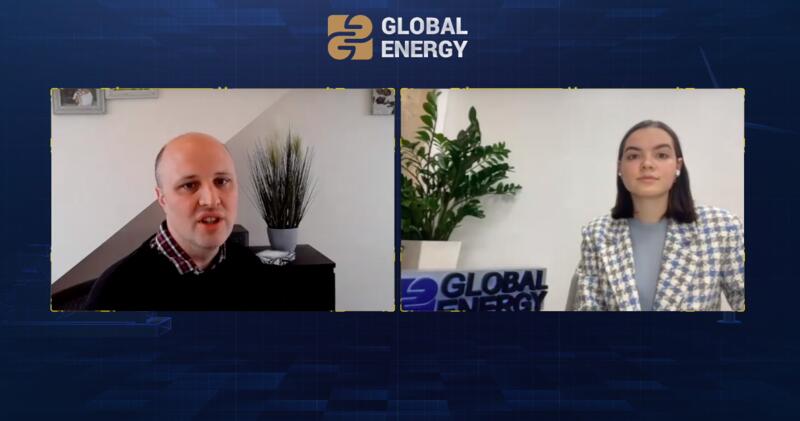Andy Smallbone presents Industrial CCS in Global Energy Association Ten breakthrough energy ideas report

DEI Fellow Andy Smallbone invited to present one of 10 most promising groundbreaking energy technologies of decade in The Global Energy Association report published at the Petersburg International Economic Forum.
The Global Energy Association presented its second annual report “Ten breakthrough ideas in energy for the next 10 years” at the Petersburg International Economic Forum in a session featuring political and industry leaders from around the globe. DEI Fellow Andrew Smallbone, Director of EPSRC Network+: Decarbonisation of Heating and Cooling was invited to write the first chapter on Industrial carbon capture and storage technologies.
He outlines how carbon capture allows to decarbonise infrastructure quickly without rebuilding it again. How it is important to integrate carbon capture or even carbon utilisation into the common industrial processes and their supply chains. He also disucsses opportunities to take captured CO2 and turn it into other commodity products and refers to Durham research on developing a new plastic which uses waste organic material and absorbs CO2 as it is manufactured.
Dr Smallbone's article outlines:
- The challenge of decarbonising industry
- The challenge of decarbonising thermal energy
- A solution for integrated decarbonised industrial sector
- Key elements of a CCUS Industrial Cluster
- Ammonia for fertilizers and marine fuel
- Plastics for food product packaging
During an interview with Global Energy on the release of the association's new report Dr Andrew Smallbone said “To achieve the goals of the Paris Agreement, carbon capture and sequestration technologies need to be introduced as soon as possible”.
Among the authors of the report are researchers from the United States, the United Kingdom, the Netherlands, Denmark, Spain, China and Russia.
The 10 breakthrough ideas presented in the report’s second edition are:
- Industrial carbon capture and storage technologies
- Digital twins (virtual copies of physical objects).
- Floating Solar Stations.
- Blue hydrogen (hydrogen produced from steam reforming of natural gas).
- Catalytic Methods for Processing Carbon Dioxide from Coal-Fired Generation into Useful Products.
- High-Quality Motor Fuels from Vegetative Raw Materials (technologies allowing for production of biofuel comparable with oil products in terms of technical characteristics).
- High Temperature Heat Pumps (heat pumps working with CO2).
- Technologies for Managing Oil Field Wastes (technologies for disposal of drilling slurry).
- Ultra High Voltage Power Transmission Technology (technologies which allow for effective transport of electricity).
- Power to E-Fuel (transforming electricity into hydrogen through power electronics).
The presentation took place within the framework of a session which featured Alexander Novak (Russian Deputy Prime Minister), Oleg Aksyutin (Deputy Chairman of the Management Committee – Head of Department 623, Gazprom), Saad Sherida Al-Kaabi (Minister of Energy of Qatar), Abdulaziz bin Salman al-Saud (Minister of Energy of Saudi Arabia), Sama Bilbao y Leon (Director General, World Nuclear Association), Andrei Ryumin (General Director, Rossetti), Angela Wilkinson (Secretary General, World Energy Council), Victor Khmarin (Chairman of the Management Board – General Director, RusHydro), Rae Kwon Chung (2007 Nobel Peace Prize laureate), Tareck El Aissami (Venezuela’s Vice President & Minister of Industries and National Production & Minister of Petroleum) (online). Acting as moderator was Sergey Brilev, President of the Global Energy Association. Watch the film of the session at the Petersburg International Forum outlining the 10 breakthrough energy ideas.
Russian Deputy Prime Minister Alexander Novak said:
“The wide variety of themes in the report shows yet again that assumptions that energy transition is something of a straight line from fossil fuels to renewable energy sources are an exaggeration,”
“More properly, we are talking about a transition to sustainable development which allows for niches for both fossil fuels and alternative energy.” New technologies, Novak said, provide opportunities for traditional suppliers to move forward with confidence into the low-carbon age.
Further information
“Ten breakthrough ideas in energy for the next 10 years” Global Energy Association Report (June 2021)
EPSRC Network+: Decarbonisation of Heating and Cooling
Durham research on plastic from biowaste and CO2
Durham Energy Institute research on Decarbonising Heating and Cooling


/prod01/prodbucket01/media/durham-university/research-/research-centres/health-at-durham/About-Us-Banner.png)
/prod01/prodbucket01/media/durham-university/research-/research-institutes/durham-energy-institute/technologies/heat--cooling/Heat.png)
/prod01/prodbucket01/media/durham-university/research-/research-institutes/durham-energy-institute/events/AprilConf.png)
/prod01/prodbucket01/media/durham-university/research-/research-institutes/durham-energy-institute/infrastructure/Image-pipes---Mark-Brodie.jpg)
/prod01/prodbucket01/media/durham-university/research-/research-institutes/durham-energy-institute/technologies/hydrogen-and-helium/Hydrogen-water-droplets.jpg)